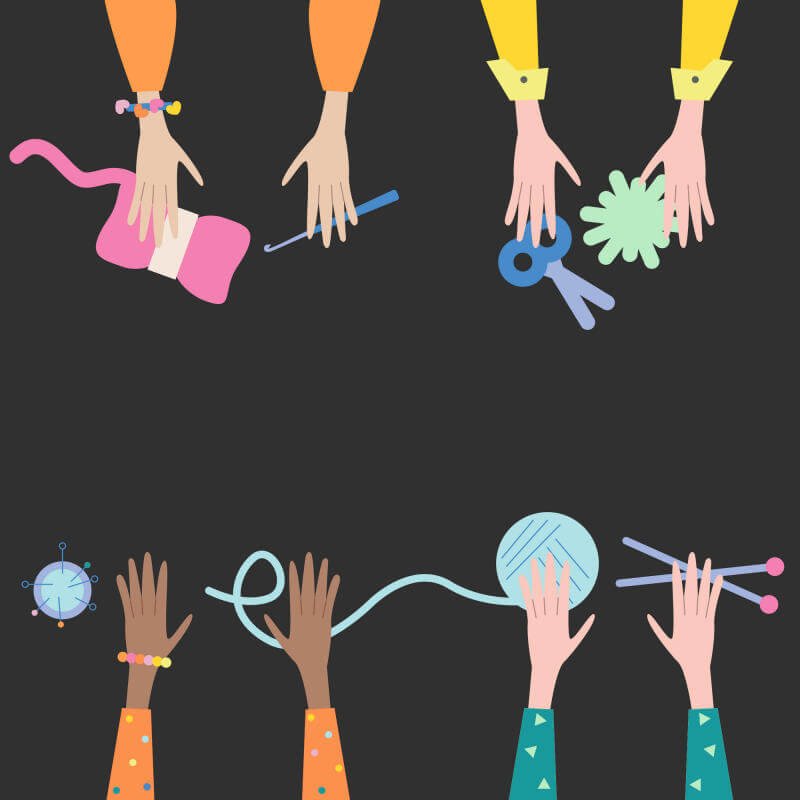Perfection Is Not Part of Crafting

Think of your best friend, your parents, or a first-grader. Would you expect them to know how to do something perfectly the first time they tried to do something new? Would you let them bad-mouth or belittle themselves if they didn’t wildly succeed in that first attempt?
Now replace your friend, parent, or first-grader with yourself. Is there a reason you are holding yourself to an unreasonable perfection standard you wouldn’t hold anyone else to?
There are no dumb questions, except the ones unasked.
I struggled with each new craft in some way. Learning sewing, I struggled with almost every step of the process. Learning crochet, I struggled to turn in order to make a chain into… well, anything else. Learning knitting, I struggled to read a pattern. Learning quilting, I struggled with free motion designs.
When I first started sewing (at age 4!), I couldn’t reach the pedal. So, someone had to help me which meant they controlled stopping and starting and the speed of the machine. Next, I learned that the fabric didn’t just appear at the sewing machine already prepped for sewing – it had to be cut out! Guess who required help to cut out that fabric? Now I could continue to describe each step of the garment sewing process and describe the parts I either wasn’t able or wasn’t allowed to do but I won’t. As I grew up, I was able to do more and more… except cut the fabric. Sigh, I still struggle when I cut fabric even today! Whether it’s for sewing garments, quilting, journal covers, or pet accessories, I regularly cut myself when cutting fabric. However, I know this is something I do not excel at, and I have learned to respect all cutting tools and especially the rotary cutter. Now, I ask for help when I know I need it. And I slow down when cutting fabric. I’ve found that I can do more crafting when my hands aren’t cut!
When I first started crocheting, I watched someone else doing it from across the room. I was too intimidated to ask how to turn a chain into rows. So I just made chains – for years! Eventually, I figured it out but I ended up with hundreds of chain belts, necklaces and bracelets instead of the sweaters, vests, and blankets that I really wanted. Now, I find someone successfully doing what I want to do and either ask them questions about it or ask them to show me how to do it. If I can’t find someone to ask in person, I will turn to the internet and find a video or blog with lots of pictures. And then ask my questions if I’m still unsure.
When I first started to knit, I learned by sitting directly across from my mother and mirroring what she did. Which meant that when she purled, I knit; when she knit, I purled. Additionally, I never saw her read a pattern as she either designed her own pattern in her head or used the same one over and over and over. The internet wasn’t a thing, and I didn’t actually know what a “purl” stitch or “knit” stitch was. So I knit the same afghan my mother knit… for years. Eventually, I bought a knitting machine that taught me a bit about dropping stitches and alternate stitches. Then, I found the website www.ravelry.com, which I highly recommend to anyone working with yarn. Several of the artists and crafters in the forums there helped me to both learn how to read a pattern and expand my abilities. I have regularly tested patterns for designers where I ask questions if I don’t understand something in the pattern.
When I first started to quilt, I didn’t know about all the different styles. Styles like echoing, trapunto, stitch-in-the-ditch, etc. I watched one segment from the Sewing with Nancy show on PBS one Saturday morning and wanted to quilt! It turns out the segment was on trapunto quilting. This means creating a puffed look where an area densely quilted outlines an area without quilting. The densely quilted area is compressed making the area without quilting look puffy and highlighted. It can be one of the more time-consuming techniques, and trapunto usually looks best on solids. My first quilt used only fabrics with busy patterns and no solids. I spent hours and hours creating the trapunto designs only to have the pattern on the fabric overwhelm the quilting. Now, I consider quilting designs when I pick out my fabric along with incorporating light/dark fabrics and patterned/solid fabric to give interest in my quilts.
Artists and crafters love to talk about their work and welcome questions.
Really! Just ask one – they don’t bite! Now, I ask questions when I don’t know how to do something or don’t understand something.
Each teacher and mentor has their own style of instruction and guidance. As your knowledge grows, you need different teachers. Find the ones that help you today. Another will appear when you need them. Look for local classes or guilds to find other artists and crafters in your area.
Learning something new is a process.
In arting and crafting, that process involves mistakes (I often call them “design elements”!) that may or may not ruin a piece or require time unmaking. When I’m learning something new, whether it’s a new craft or a new pattern or design in a craft I’ve done for years, I think about my friend, parents, and that first-grader. I think about how I’d talk to them if they were learning something new. I give myself the gift of that encouragement.
Remember: creativity is where time falls away, pain disappears, and joy fills you!
Kimberly Vallance
 |
 |
 |
